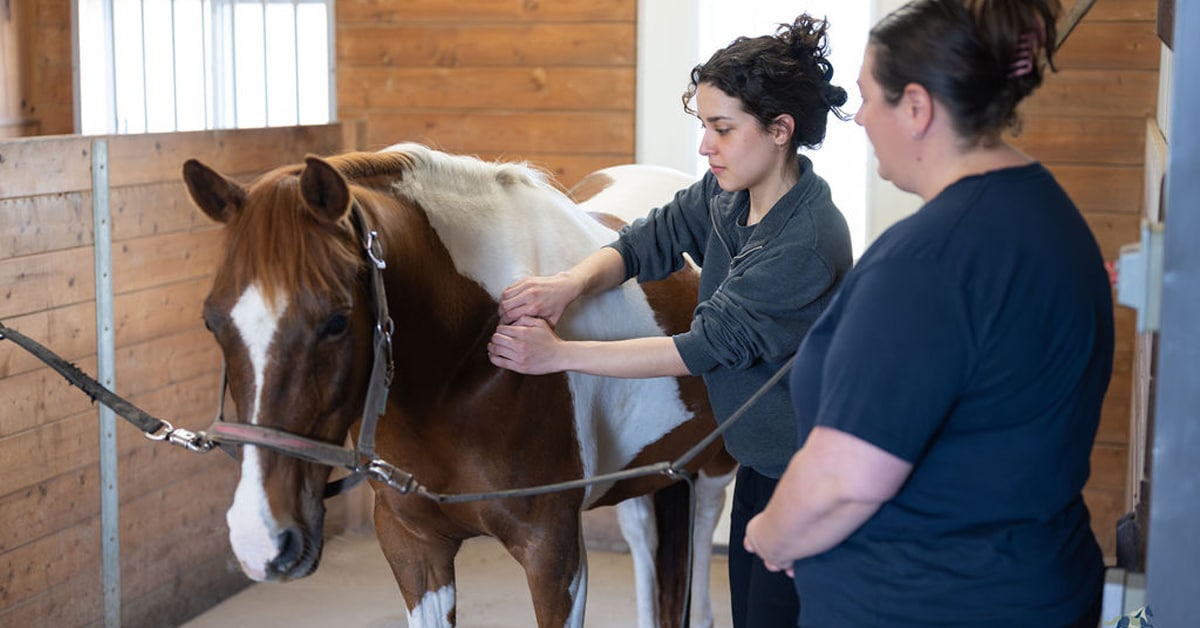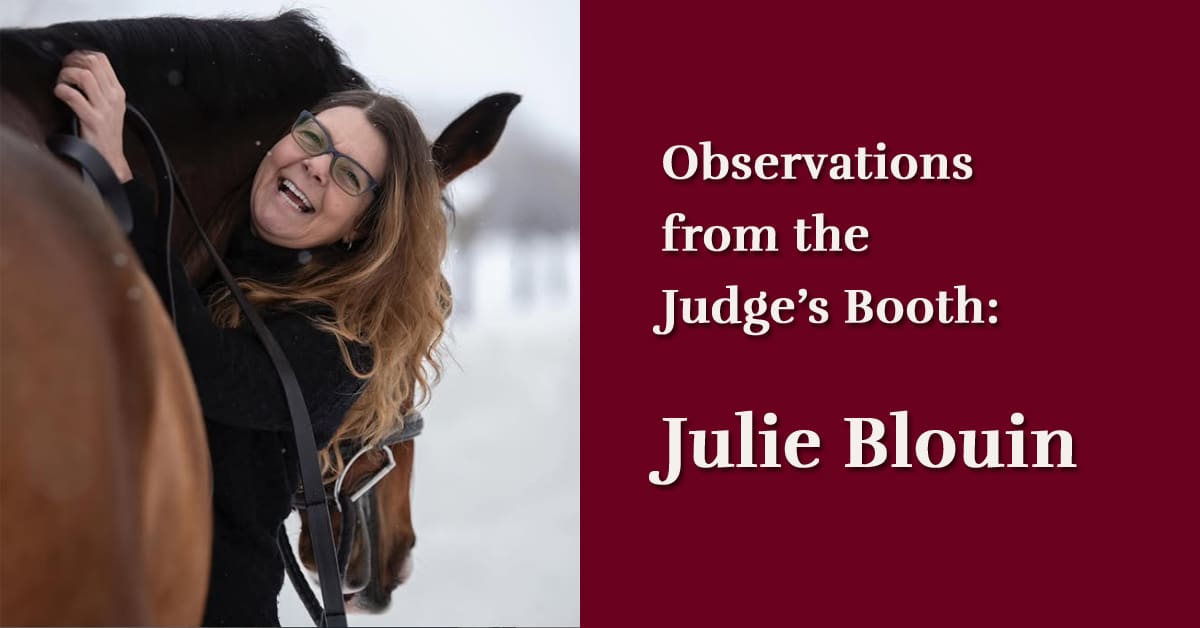Tying a horse is such a common part of horsemanship that most people never give it a thought. But if you have experienced or witnessed a horse panicking while tied to a post or a trailer, you know how dangerous it can be. Teaching your horse how to stand quietly while tied is essential for keeping both you and your horse safe.
Since a horse’s primary defense is flight, it’s understandable that they have a very powerful and instinctive fear of being restrained in any way. Training methods using strong restraints trigger fear and can make the horse “fight it out.” Tying a horse to something solid with a rope and halter that will not break can cause some horses to panic so badly that they cause serious injury to themselves, including damage to the cervical vertebrae, broken legs, or permanent nerve damage to the poll. If a horse flips over, the result can be broken withers or even death from a broken neck. Even if he does not injure himself, the horse learns only that resistance is futile (learned helplessness*). He does not learn how to trust or think.
You can teach your horse to tie safely while building his trust and teaching him to override his instinctive behaviour. A word of warning: working with a horse that has learned to break away, or panics when tied, can be dangerous. Be honest about your own ability, skill level and confidence. If you are out of your depth, get help from an experienced trainer who will work with you and your horse together.
Steps to Standing Quietly While Tied
The steps for teaching your horse to tie safely are the same steps for teaching him to lead and stand quietly. Your horse must calmly and consistently:
– give to pressure on the halter
– move forward from your pushing cue to his flank
– stand straight, square and level, even when you move away from him
Giving to Pressure – Before teaching your horse to tie, he must consistently and without any resistance give to light pressure. The pressure can be a block you put on his halter, asking him to lower his head, halt or back up; a push you send to his flank asking him to step forward; or a block to his chest asking him to stay in place. Your horse should give to pressure from all directions – left, right, forward, back, up, and down – consistently without resistance or pulling back.
Your horse’s frame of body reflects his frame of mind, so begin with your horse in a calm frame, with his body straight (spine aligned nose to tail), poll level with or slightly lower than his withers, and his feet square underneath him. Hold your lead rope with contact and the same way you hold reins – with your knuckles facing up (your little finger will be closest to your horse’s head). Keep yourself at a safe distance from your horse’s front feet in case he strikes or rears.
Apply only gentle, steady pressure on the rope. Never jerk or pull. If your horse becomes unsettled or stressed, take the time to bring him back to a calm frame before continuing with the exercise.
- Stand beside your horse’s shoulder and face forwards. Hold onto your lead rope about four inches below your horse’s chin and apply gentle, steady pressure straight down towards the ground. If he drops his head and remains calm, he is giving to downwards pressure on his poll.
- Next, apply gentle, steady pressure towards his chest. If he calmly steps backwards in a straight line with a level neck, then he is giving to the pressure on his nose.
- Repeat the exercise as above, but take your rope to the right and to the left.
- Stand about two feet in front of your horse, facing towards him. Apply gentle, steady forward pressure towards you. If your horse offers no resistance and quietly steps forward keeping his neck level, he is giving to that forward pressure on his poll. If your horse raises his head, pulls against the pressure or does nothing, then he is not ready to be tied safely.
Move Forward from Pushing Cue – Stand off to the side and slightly in front of your horse at about a 45-degree angle, with your centre (navel) aimed towards his body. Take up contact on the rope. Ask your horse to step forward by pushing into his flank with your whip or end of the rope. Be sure that you are not sending any pushing movements in front of his shoulder or into his head; that would stop him from coming forward and you would be giving him a mixed message of “go forward but don’t go forward.” That will confuse him and can cause panic, as he will be in a no-win situation. Stop pushing as soon as your horse takes a step forward. Reward him with a soft voice and by stroking his withers.
Standing In Place – Begin with your horse standing quietly in a calm frame. Ask him to stay in place while you move away. Give him the signal to stay by pointing at his chest with your hand or whip as you step away. You can also add a voice cue. If your horse follows you, calmly correct him by asking him to step back until he is in the same place he started from by putting blocking pressure on the lead rope and pointing at or gently tapping his chest with your hand or whip. Give him the “stand” cue again.
Expect to repeat this step a number of times. As your horse figures out what you are asking and stays in place, gradually expand the distance between you to about six feet.
Ready to Tie – To keep yourself and your horse safe, you’ll need:
– an area clear of anything your horse might bump into or step on;
– safe footing so your horse will not slip or stumble;
– a secure object to tie him to (e.g. fence post or securely fixed tie ring) at or slightly above the level of his back;
– a long cotton lead rope in good condition that allows your horse to stand about two feet away from what he is tied to. He should be able to move a bit but not get tangled;
– a well-fitted web or leather halter in good condition.
With your horse in a calm frame and standing a couple of feet away from where he will be tied, put the end of the rope through the ring or around the post and hold the end. Do not tie the rope yet. If your horse pulls back, hold the rope to create a blocking pressure (do not pull) and give him the “step forward” cue to his flank. If he steps forward, he will release the pressure on the rope. If he panics and continues to pull back, release your block and let the rope slide through your hand. When he feels the pressure release, he will stop pulling back. Calm him down before starting again.
Only when your horse stands quietly and consistently gives to pressure on his poll should you tie the rope. Always use a quick-release knot or a quick-release clip. Attach the quick-release clip to the tie ring rather than to your horse’s halter. If your horse panics, you can quickly release the clip without putting yourself in danger of being hurt and still have something with which to hold onto him. Allow some slack in the rope, but not so much that your horse can step on or over it.
Your horse may test the rope. If he pulls back, give him the “go forward” cue just as you did when you were holding the end of the rope. If he panics, quickly release the clip or knot to relieve the pressure.
Teaching your horse to stand calmly, give to pressure and think rather than react instinctively takes time, patience and persistence. But the results are a trusting, confident and calm partnership that keeps you both safe.
The Latest









